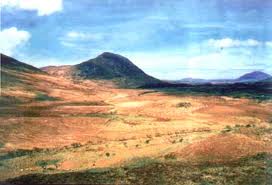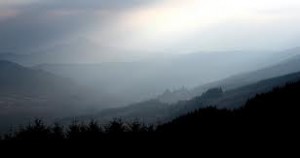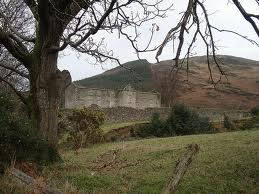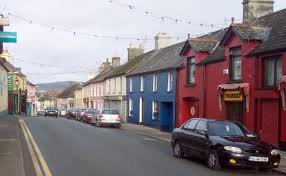The Wicklow Mountains and cycling through the past.
 John Dorney takes a two wheeled journey through the Wicklow mountains’ past and present. See also a journey though the Pale.
John Dorney takes a two wheeled journey through the Wicklow mountains’ past and present. See also a journey though the Pale.
In Medieval times, the mountains south of Dublin marked the border between two worlds. In the lowlands and the city, the settled English speaking world was defended from its enemies by the Pale, an earthwork fortification the remnants of which are still to be found in parts of south Dublin.
In the mountains all was wildness; wild heather, wild deer, wild sheep and wild people. The Gaelic clans, especially the O’Tooles and O’Bynes, preyed on the Palesmen below. Every year on “Black Monday”, the Dublin citizens would march out of the city to Ranelagh, site of a massacre in 1209 and raise a black banner with a raven emblem in the direction of the mountains to challenge the Irish to battle in a gesture of symbolic defiance of the “mountain enemy”.
Today the mountains are still the antithesis of the city below. All wilderness and nature where the city is clamour and noise. And still, in my imagination at least, a separate, more real world.
Bicycle as time machine
The bicycle is fast enough to travel through the mountains but slow enough to see, hear and smell them. There’s a lung-bursting climb up Stocking lane (so called because British troops policing the mountains after the 1798 rebellion used to restock here) over the first crest of the Mountains. There was a time when I could dance up these hills in my French cycling kit, but now I have a paunch around my midriff and I gasp for air and have to stop for rests on the steepest slopes.
In the real uplands the roads deteriorate into piles of loose chippings and the tree cover and houses both disappear from the side of the road and when I stop to get my breath on the steepest sections, I feel the arteries in my neck throbbing and when I close my eyes and open them again I see lights dancing in front of them.
As you crest the hill at Glenasmole, the valley is sometimes covered in white cloud, with rain spitting sideways from the west almost vertically into your right eye. In Dublin slang this valley is known as the ‘Featherbeds’. The last native speaker of the Irish language in county Dublin died here in the early 19th century.
On a wet day around the Sally Gap you can see strings of white, rain-filled cloud racing up the Liffey’s valley. Sheets of wild rain pour down. Around Glencree there are still signs of civilization. Climbing past Lough Bray telephone poles line the mountain road. But all of this ends after the Sally Gap – no fences, no telephone lines, no houses. Only the hard-packed gravel road hacked out of the bog by British soldiers 200 years ago to track down Michael Dwyer and his band of United Irish guerrillas after the rebellion of 1798.
IRA leader Ernie O’Malley wrote of the area in 1922,
“We crossed the narrow military road built after the rebellion of 1798; Michael Dwyer and his men then fought in the hills near Imail [sic]. That fighting in our country had given the large armies of the British a surprise; with the road the mountainous areas would then be more easily penetrated, or so they thought. The British were always ready for the last rebellion… The country was bare and treeless, stretches of heather and soggy bogland, practically unreclaimable. A bird on the wing, plover or the startled rush of a snipe. It was strange to have such a wilderness within twelve miles of Dublin”.

At this point you’re in a vast brown heather bowl, ringed by mountains on all sides – like a huge natural amphitheatre. The sense of isolation is only increased by the on-off bouts of rain. And the sheep, who look at you as if you’re an idiot before either grudgingly sidling out of your way or else panicking and sprinting into the ditches away from the strange two-wheeled animal.
Past the hill-tops, a couple of valleys away, you can see the softer, greener, inhabited, parts of the mountains. But here you won’t see any houses until you descend from Glenmacnass on the road into Laragh, where the road becomes tree-lined again.
The rain and mist descending on a cleft in the hills bedded with oddly determined looking trees is a sight to behold. As well as settling over the trees, the rain spits in your face and into your eyes and drips off your cycling cap in dispiriting little drops and coats your cycling jacket so thoroughly that you’re actually glad to be climbing so that you’re still warm.
There are no houses but there are the walls of farmsteads abandoned long ago that you’ll see in little green valleys among the heather. These poignant little ruins dot the highlands.
The writer John Millington Synge tramped and cycled through these mountains at the turn of the twentieth century, when it was already emptying of people. The mountain life was simply too hard for people who could leave for Dublin or Liverpool or New York. He noted a sadness about the older people as their children left the area. Today the emptiness of the landscape is almost eerie.
Synge too was caught in the mountain rain. Writing of Glencree in 1897,
“I have come out again on the mountain road the third day of the fog. At first it was misty only and then a cloud crept up the water gullies from the valley of the Liffey, and in a moment I am cut off in a white silent cloud. The little turfy ridges on each side of the road have the look of glens to me and every block of stone is the size of house…I see wet cottages on the other side of the glen that I had forgotten. Then as I walk on, I see out over the cloud tops to real mountains standing up into the sky”.
The mountains and their secrets
These mountain have their secrets. On the left hand side of the road is a sad, lonely memorial to Noel Lemass, murdered here in 1923 in the Irish Civil War, “erected by his friends”. Every year brings more recent stories of bodies found in these hills, victims of everything from domestic violence to gangland assassinations.
The military road is dotted with abandoned barracks. At  Glencree, the former barracks nestles into the side of a valley. Later it was a ‘reform school’ for young offenders. Now it’s a centre for Reconciliation of Conflicts -both Irish and international. Descending into Drumgoff, you’ll see a massive ruined structure – a fortified barracks built in the 19th century to garrison Michael Dwyer’s stomping grounds. Further down the same road is a much older military base – a slowly decaying Elizabethan keep, built in the late 16th to keep an eye on, or hem in, Fiach McHugh O’Byrne – a Gaelic raider who defeated an English army here in 1580.
Glencree, the former barracks nestles into the side of a valley. Later it was a ‘reform school’ for young offenders. Now it’s a centre for Reconciliation of Conflicts -both Irish and international. Descending into Drumgoff, you’ll see a massive ruined structure – a fortified barracks built in the 19th century to garrison Michael Dwyer’s stomping grounds. Further down the same road is a much older military base – a slowly decaying Elizabethan keep, built in the late 16th to keep an eye on, or hem in, Fiach McHugh O’Byrne – a Gaelic raider who defeated an English army here in 1580.
Some sights in the Wicklow Mountains are yet older. At Three Rock overlooking Dublin and along the road from the Sally Gap to Laragh are Dolmens and standing stones erected before there was written history.
The road from Laragh to Rathdrum is, after the real uplands, like being released from the painful grip of a much stronger being. For a start, the road is flatter, the kilometers now spin away under your wheels instead of groaning terrifyingly slowly under each pedal stroke. And it’s warm – bright and warm – the sheeting rain is replaced by a kind sun. The scenery also becomes beautifully mild. You follow a river along a bright green, cheery valley. The villages along the way seem comforting compared to the starkness you’ve left behind.
In Rathdrum there’s a big square, stone mill beside the river and a steep, steep hill separating it from the town. The village is just one street of solid stone built houses and shops huddled very close together as if for comfort. There’s a little memorial right in the centre of town for two IRA men killed by the British in 1920. Wicklow was not a hive of rebel activity in the revolutionary years, but the cycling enthusiast and amateur photographer Robert Chapman remembered of cycling through village of Aghavanagh in 1919, “As we struggled along the level and bare bog road, we were mistaken by some men working nearby for Sinn Feiners out campaigning [for election] and a tremendous cheer went up which was returned”.
 Rathdrum has a market square but, as far as I know, no market. The rally and crowd scenes at the start of Neil Jordan’s 1996 film, Michael Collins were filmed here. Jordan’s reenactment of Collins’ death was filmed not far away but over a great hump of mountain, near Hollywood in west Wicklow. Perhaps because of this ‘General’ Michael Collins has his picture in all the pubs in Rathdrum and Drumgoff, in his National Army uniform with pistols slung jauntily in a holster at his waist, beside the local boys Fiach MacHugh and Michael Dwyer (patriots all!). The exploits of the latter two are also commemorated in two great lumps of stone in the Glenmalure valley.
Rathdrum has a market square but, as far as I know, no market. The rally and crowd scenes at the start of Neil Jordan’s 1996 film, Michael Collins were filmed here. Jordan’s reenactment of Collins’ death was filmed not far away but over a great hump of mountain, near Hollywood in west Wicklow. Perhaps because of this ‘General’ Michael Collins has his picture in all the pubs in Rathdrum and Drumgoff, in his National Army uniform with pistols slung jauntily in a holster at his waist, beside the local boys Fiach MacHugh and Michael Dwyer (patriots all!). The exploits of the latter two are also commemorated in two great lumps of stone in the Glenmalure valley.
Charles Stuart Parnell, the constitutionalist nationalist leader was of course also from these parts – there’s a Parnell memorial park for him in Rathdrum. There are lots of reason though, why people would rather remember Michael Collins (who to my knowledge never even visited these hills) than Parnell. For one thing, Collins was ‘one of us’ a lower middle class Catholic and not, like Parnell a patrician, nationally minded Anglo-Irish landlord. There remains an outlaw glamour attached to the use of violence as well. And of course, Collins has his own movie.
At one end of the town, near the railway station is the Protestant Church built in 1620 – though remodeled later. At the other end is the Catholic – which is highly ornate, complete with statues of angels slaying demons and also, in a 19th century manner very neat and well appointed – to an almost Protestant degree.
The road to Glenmalure is more lumpy than hilly. When you get to the end of the paved road, you must carry your bike across a stream and onto a little walking track. A really cute An Oige hostel stands in your path, built in 1938, facings in bright green with old-style Gaelic lettering. It’s kind of touching to think of the new state building these little structures around the country, imagining that generations of nationalist youth would wander the country and somehow discover in the landscape the ‘real’, unconquered Ireland.
I tried riding the track beyond into the u-shaped valley that is Glenmalure, but the hillsides, like a Chinese Communist rally of the Maoist period, are lined with red flags. In fact this tells you not that the workers of Wicklow have cast off the shackles of capitalism but that the Irish Army is practicing its artillery firing over the hill in the glen of Imaal. A few ‘clangs’ in the distance put me off going any further.
Modern follies
Even in Rathdrum the Celtic Tiger’s monuments can be seen. Asking for directions to the campsite in Rathdrum, a man with short hair and short sleeved shirt told me that it was at the bottom of the hill beside the office and apartment block, “well you know, it’s not open but…”.
Sure enough at the bottom of the hill there’s a newly built but quite empty complex, complete – just like the ones in central Dublin – with electronic buzzer and underground car park. What is it doing here in this mountain village? One can imagine the advertisement, “40 minutes from Dublin, scenic location” etc. Did anyone really believe this? Now it sits there gathering dust, a little like the follies 18th century landlords would build for their own amusement, but much less easy on the eye.
Perhaps 200 hundred years from now people will come upon it, as they now do the barracks at Drumgoff and wonder whatever it could have been.